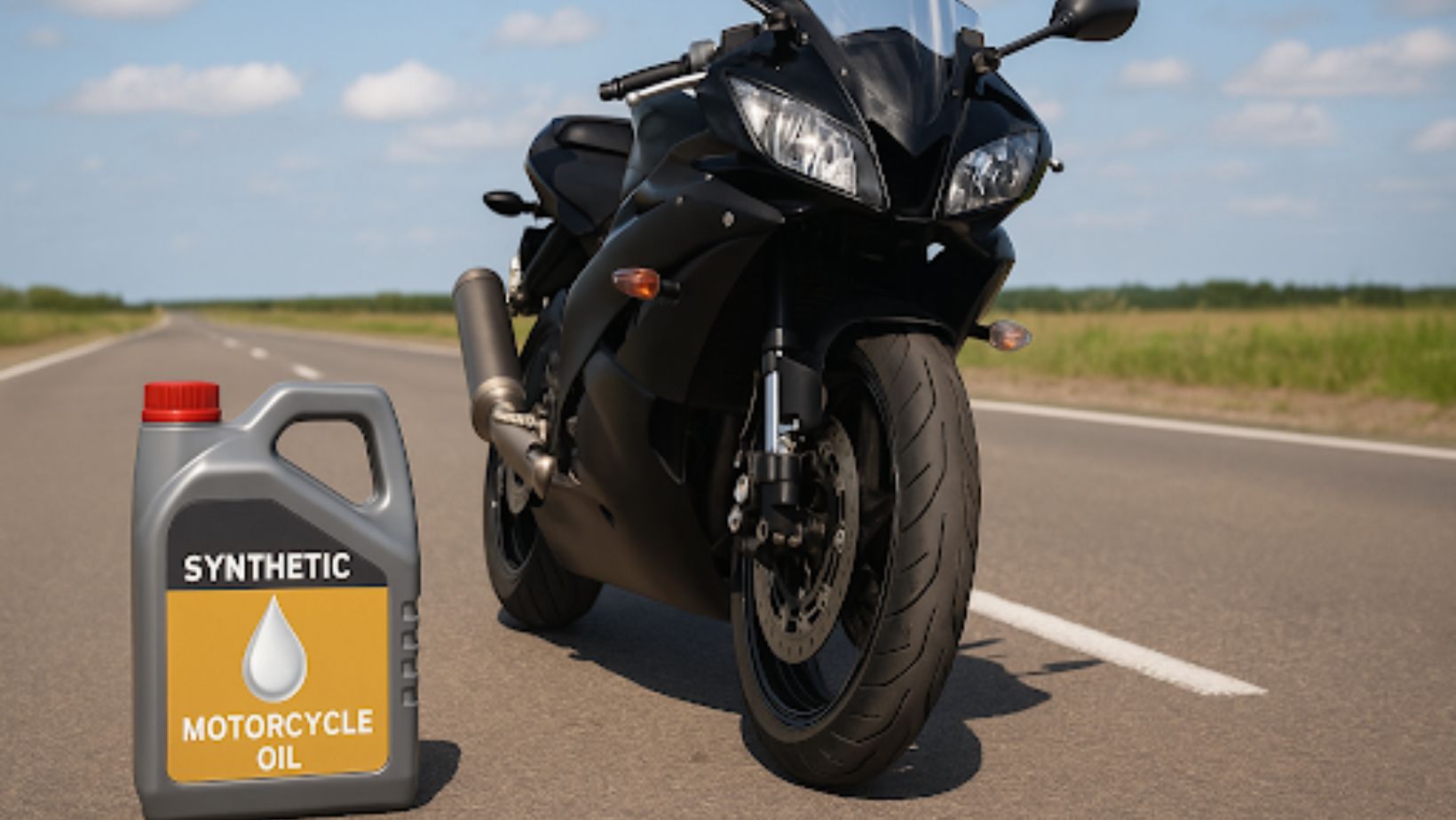 Many bike riders face engine problems after a few months of riding. The engine starts to heat up quickly, makes rough sounds, or doesn’t run as fast as before. Even after changing the oil, things don’t always get better. This can be confusing and stressful, especially when you take care of your bike.
Many bike riders face engine problems after a few months of riding. The engine starts to heat up quickly, makes rough sounds, or doesn’t run as fast as before. Even after changing the oil, things don’t always get better. This can be confusing and stressful, especially when you take care of your bike.
One common reason for this is using the wrong type of oil. Regular oil can’t always protect your engine during long or fast rides. A majority of riders prefer synthetic motorcycle oil for performance bikes. This oil ensures your engine remains cool and clean while maintaining its strength, which leads to improved performance and extended bike life.
What Is Synthetic Motorcycle Oil?
Synthetic oil is a type of engine oil made in labs. It is designed to work better than regular oil, especially in strong engines that heat up quickly. While regular oil is made by cleaning crude oil from the ground, synthetic oil is created using special chemical processes.
Motorcycle oil helps your engine stay cool and clean. It also stops parts from rubbing too hard and getting damaged. Now, there are two main types of oil:
- Regular oil (also called mineral oil): Made straight from crude oil.
- Synthetic oil: Made in labs with better, cleaner ingredients.
Synthetic motorcycle oil is like giving your engine a superpower. It is built to work in very hot or very cold conditions and protects your engine much better than regular oil.
Why Performance Bikes Need Synthetic Oil
Performance bikes have powerful engines. Performance bikes achieve high speeds while operating at maximum RPMs, which causes them to heat up rapidly. Basic or cheap oil in these bikes doesn’t perform well because it’s like using weak batteries in a strong flashlight.
Synthetic motorcycle oil plays a crucial role in performance bikes because it meets their unique demands.
- Better Protection: A strong layer formed by synthetic oil protects engine parts from friction damage.
- Works in High Heat: Performance bikes can get super hot. Synthetic oil retains its stability even when exposed to extreme temperature conditions.
- Cleans the Engine: This oil absorbs dirt particles to maintain internal engine cleanliness.
- Longer Lasting: Synthetic oil requires fewer frequent changes compared to standard oil.
Switching to synthetic oil is a wise decision if you want to extend your bike’s life and maintain its performance and power. Riders prefer this oil because its design supports high-pressure operations.
What Happens If You Don’t Use the Right Oil?
Using incorrect oil can cause several problems, such as engine failure and performance issues.
- Engine overheating
- Slower performance
- Rough gear shifts
- Engine knocking or strange sounds
- Shorter engine life

Avoid engine problems by not waiting until it becomes noisy or starts to perform poorly. Early maintenance results in fewer repairs as time goes on.
Benefits of Synthetic Motorcycle Oil for Performance Bikes
We will now discuss each major benefit separately.
1. Fights Heat
Synthetic oil maintains its structure under high engine temperatures. It becomes crucial for maintaining performance throughout extended rides and during peak summer temperatures.
2. Reduces Engine Friction
Less rubbing means less damage. Your engine operates more smoothly while consuming fuel with greater efficiency.
3. Longer Oil Life
Synthetic oil doesn’t break down quickly. By extending the intervals between oil changes when using synthetic motorcycle oil, you save both time and money.
4. Cleaner Engine
Engines can become clogged with dirt and gunk over time. Synthetic oil functions to remove sludge buildup and stops engine clogs from forming.
5. Cold Start Support
The oil flows more effectively at low temperatures, which simplifies engine starts during winter.
The advantages of synthetic motorcycle oil make it the preferred choice among riders for performance bikes. This product is specifically engineered to match your engine’s power and speed capabilities.
How to Choose the Greatest Synthetic Oil for Your Bike
Not all synthetic oils are the same. Certain synthetic oils perform better in racing conditions, while others excel in urban transportation situations. To select the optimum synthetic oil for your motorcycle, follow these steps.
Check the Viscosity Grade
Look at your bike’s manual. The numbers “10W-40” or “5W-30” show whether the oil needs to be thick or thin. Always select the recommended oil grade specified for your motorcycle.
Look for API and JASO Ratings
These standards prove that oil has undergone testing and meets safety requirements. The optimal motorcycle oil classification for bikes falls under JASO MA or MA2.
Read Comments and Ask Other Riders
What do other people say? When numerous bikers express their preference for a specific oil, it is typically a wise option.
Purchase from a Trusted Brand
Choose motorcycle oil from reputable brands instead of selecting the least expensive option available. If you’re still unsure, you can always go with Vyscocity synthetic motorcycle oil for performance bikes, which is made especially for riders who want high performance and smooth riding.
How Often Should You Change Synthetic Oil?
Performance bike specialists recommend changing synthetic oil every 3,000 to 5,000 miles, according to most expert opinions. However, this can depend on:
- How often do you ride
- The weather in your area
- Your bike model
Your bike’s manual contains the proper maintenance schedule. Pay attention to indicators such as dark engine oil and performance drops, along with unusual engine sounds. If you notice these signs, it could indicate that a change is required.
Can You Switch to Synthetic Oil Anytime?
You can change to synthetic oil from regular oil at any time you choose. Before you add new oil, completely drain the old oil from the system.

There’s a myth that switching causes leaks. But that’s not true for modern engines. A well-maintained bike will operate without any problems.
For optimal results during an oil change transition, choose synthetic oil that’s formulated specifically for motorcycles. Avoid using engine oil designed for cars because it won’t function effectively.
How to Change Your Motorcycle Oil (Quick Steps)
This guide offers an easy step-by-step process for changing your oil at home.
- Warm up your engine for 2–3 minutes.
- Place an oil pan under the bike.
- Take off the drain plug to allow the old oil to drain out.
- Remove the old oil filter.
- Place the new oil filter and ensure it’s secured gently.
- Put the drain plug back in.
- Pour in the new synthetic oil slowly.
- Use the dipstick or sight glass to measure the motorcycle’s oil level.
- Start your motorcycle engine and allow it to run uninterrupted for one full minute.
- After starting your engine, examine your bike for oil leaks and adjust the oil level as required.
Should you feel uneasy about doing this work by yourself, then seek help from a professional mechanic. Learning basic maintenance is essential when you ride your motorcycle frequently.
Final Thoughts
Every motorcycle maintenance routine begins with fundamental steps where oil plays an essential role. Riding a performance motorcycle requires synthetic motorcycle oil because it transitions from being a desirable option to an essential requirement.
Your engine receives protection while your speed improves, and you save money over time, enabling you to ride with peace of mind.
Your bike deserves the best. Each ride will allow you to experience the benefits of using synthetic motorcycle oil.



